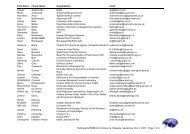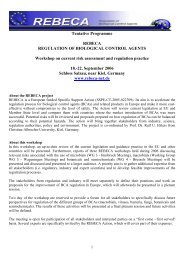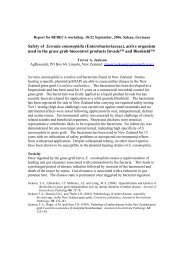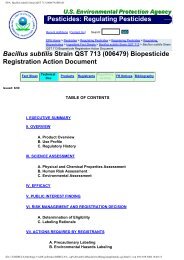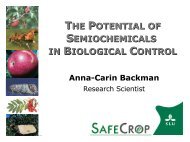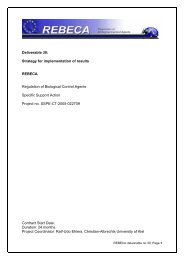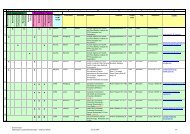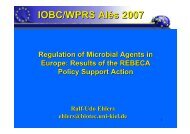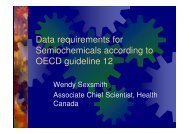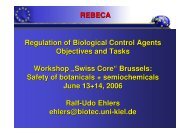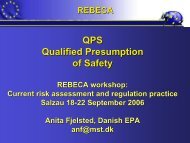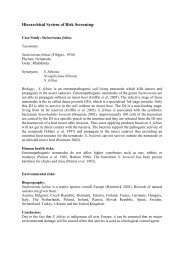Deliverable 28: Specification of low risk products REBECA ...
Deliverable 28: Specification of low risk products REBECA ...
Deliverable 28: Specification of low risk products REBECA ...
Create successful ePaper yourself
Turn your PDF publications into a flip-book with our unique Google optimized e-Paper software.
For a given chemical pesticide, the dispersal factor would be calculated by<br />
determining the maximum dispersal distance and quantity, taking into account spray<br />
drift, run-<strong>of</strong>f and leaching, dispersal via bioaccumulation, and through evaporation.<br />
Similarly, when scoring for micro-organisms spray drift, leaching and run-<strong>of</strong>f will be<br />
considered. Additionally, the dispersal through infected organisms must be<br />
accounted for, as this can involve the transport <strong>of</strong> significant quantities <strong>of</strong> infectious<br />
material over long distances.<br />
In the absence <strong>of</strong> more detailed knowledge the fol<strong>low</strong>ing generalized worst case<br />
assumptions are applied: for spray applications, drift is assumed to disperse 10 % <strong>of</strong><br />
the applied active ingredient up to 100 m (Pest Management Regulatory Agency,<br />
2007); for microbials pathogenic to insects, unless other information is available, a<br />
dispersal distance <strong>of</strong> up to 1000 m is assumed due to the possibility <strong>of</strong> infected<br />
insects spreading the inoculum.<br />
Range <strong>of</strong> non target effects. Most bacteria and fungi have, under certain<br />
conditions, the potential to act as opportunistic pathogens and infect species<br />
normally not susceptible to the organism. These conditions include high inoculum<br />
concentrations, climatic conditions suitable for the micro-organism, and/or<br />
circumstances under which the immune response <strong>of</strong> the potential host is weakened.<br />
It is, therefore, important to differentiate between the physiological and the ecological<br />
host range (Onstad & McManus, 1996; Jaronski et al., 1998; Jaronski et al., 2003;<br />
Meyling et al., 2005). For an environmental <strong>risk</strong> assessment only the ecological host<br />
range <strong>of</strong> a biological control agent is <strong>of</strong> interest. As a consequence, laboratory<br />
studies on non-target organisms should be designed to reflect natural conditions.<br />
Likewise for chemicals, the target range assessment should be done at<br />
concentrations realistic for a typical application scenario. Where available NOEL<br />
levels, dose-response curves or <strong>risk</strong> quotients (estimated environmental<br />
concentration over toxicity) should be used for this assessment.<br />
Table 3 Assignment <strong>of</strong> scores for non-target effects. Modified from Hickson et al.<br />
(2000) and Hokkanen et al. (2003) to better suit the inclusion <strong>of</strong> chemical pesticides<br />
in the proposed system.<br />
Range <strong>of</strong> non-target effects<br />
Score Likelihood Magnitude<br />
1 1 species Genus<br />
2 2-3 species Family<br />
3 4-10 species Order<br />
4 11-30 species Class<br />
5 > 30 species >= Phylum<br />
Once the range <strong>of</strong> possible affected non-targets is determined, the score in this<br />
category can be calculated as described in Table 3. Should significant indirect effects<br />
occur, the number <strong>of</strong> affected species (irrespective <strong>of</strong> the taxonomic level) must be<br />
included when scoring for the range <strong>of</strong> non-target species.<br />
While the scoring guidance for non-targets described above is relatively<br />
straightforward, the antagonistic suppression <strong>of</strong> microbial growth to control plant<br />
22



